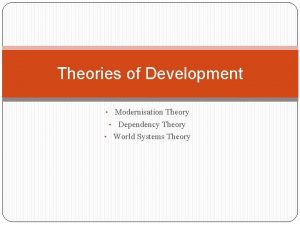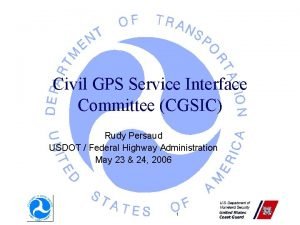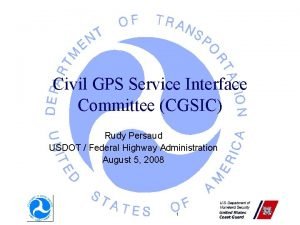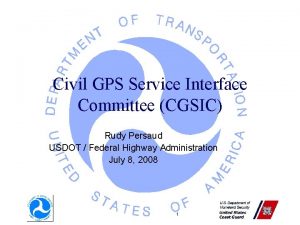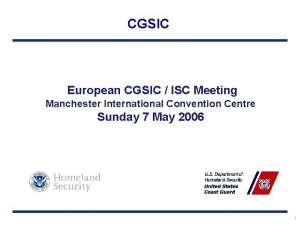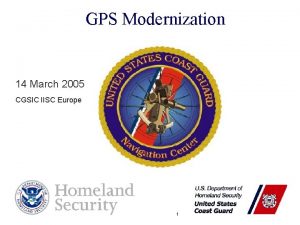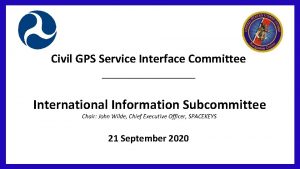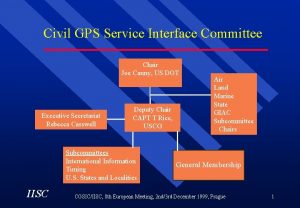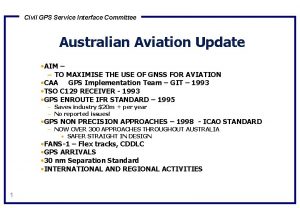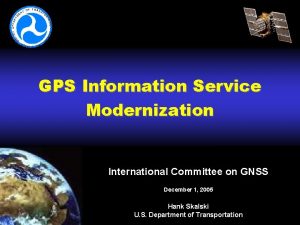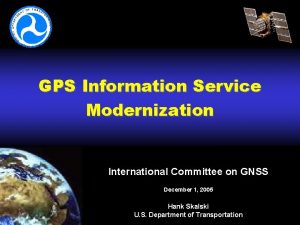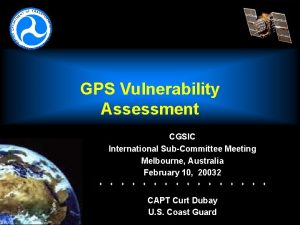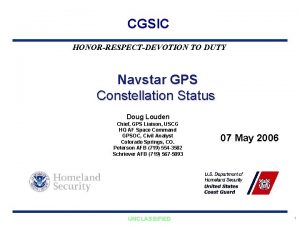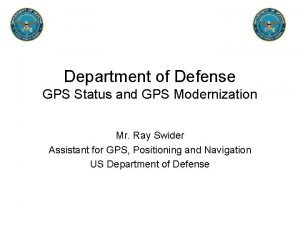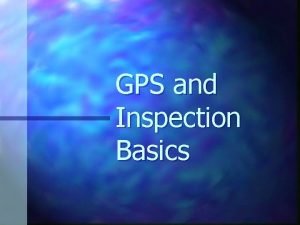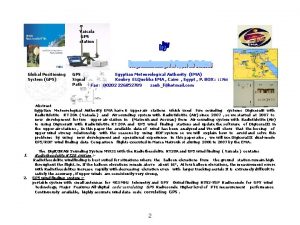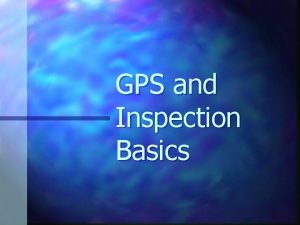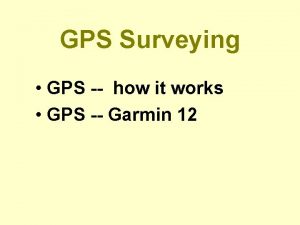GPS Modernization Civil GPS Service Interface Committee CGSIC






























- Slides: 30

GPS Modernization Civil GPS Service Interface Committee (CGSIC) Salt Lake City, UT 10 Sept 2001 Lt Col John Wilt, USAF Deputy, System Engineering Division Navstar Global Positioning System (GPS) Joint Program Office Los Angeles AFB CA

Overview n n n Constellation Status GPS Modernization GPS III Program Challenges Summary 2

Constellation Status 28 Operating Satellites n 22 Block II/IIA operational satellites n n Block IIA life expectancy reduced slightly (to 10. 23 years) 6 Block IIR satellites on orbit Last launch 31 Jan 01 n 14 of 21 Block IIR satellites available n Modernizing up to 12 Block IIR satellites n n Next Launch: Mar 02 Tentative launch dates: Jun 02; Oct 02 n Continuously assessing constellation health to determine launch need n 3

GPS Constellation Snapshot Block II 9. 2 yrs Predicted Mean Mission Duration (MMD) Block IIA 10. 23 yrs YEARS OPERATIONAL Block IIR 10 yrs (estimated) SV NUMBER DEACTIVATED BLOCK IIA BLOCK IIR 4

Overview n Constellation Status n GPS Modernization n GPS III Program n Challenges n Summary 5

FOR OFFICAL USE ONLY GPS Modernization GPS Enterprise Perspective FY 01 02 03 04 05 06 System Milestones 07 08 09 10 11 12 13 14 15 1 st Hi. M- Power MCode SV Code IOC FOC 1 st SAASM OA M-Code IOC L 5 SV SV Space Segment L 5 IOC L 5 FOC 16 17 18 19 Hi. Power IOC Hi. Power FOC Heritage Launches M-Code (IIRM/IIF) Launches 1 st IIR Mod 1 st IIF III Launches GPS IIIGPS Launches EMD 1 st GPS III Control Segment Functionality Development SAASM Capable Test V 5. 5 Dev. Initial Legacy Upgrade V 5. 2 M-Code Capable V 6. 0 User Equipment M-Code + Power Capable SAASM UE 1 st Platform to Use Capability SAASM (CSEL) SAASM UE Producton / Platform Installs 1 st LRIP RCVRs Full-Rate Production M-Code UE Development UE Fielding Tecolote Research, Inc. SAASM Production / Platform Installs GPS JPO Schedule Management M-Code Hi-Power Increasing Percent Fielding Dev Test Jun 01 6

GPS Space and Control Block IIR Modernization Pre-Modernization n Heritage Signals Post Modernization n Higher Power n L 1 C/A, L 2 Second Civil n L 1, L 2 P(Y) n L 1, L 2 M-Code n L 1 C/A n L 1, L 2 P(Y) n n Design Life n 10 Years Modernized Signals n Design Life n 10 Years 7

GPS Space and Control Block IIF Modernization Post Modernization Pre-Modernization n Heritage Signals n L 1, L 2 C/A n L 1, L 2 P(Y) n Design Life n 15 Years n 1 Rubidium and 3 Cesium Clocks n 33 Satellite Production Run * L 2 Civil Signal design supports varying code length and data structure n Modernized Signals * n Similar Power n L 1 C/A, L 2 Civil Signal n L 1, L 2 P(Y) n L 1, L 2 M-Code n L 5 New Civil Signal n Design Life n 12 Years n 10 Year MMD n 2 Rubidium Clocks and 1 Cesium n 12 Satellite Production Run 8

GPS Space and Control Segment Modernization Pre-Modernization n Upgrade Schedule n Version 3/4 n 1402 KSLOC n Delivery n Version n 269 Sep 01 5 KSLOC n Single Delivery Sep 03 / Ops Jan 05 n High n Version n Size Risk 6 34 KSLOC n Delivery Sep 05 / Ops Mar 07 Post-Modernization n Upgrade Schedule n Version 3/4 n 1402 KSLOC n Delivery Sep 01 n Mod Test Legacy Upgrade n Version 5 n 300 KSLOC n Incremental Deliveries begin Jun 02; Ops Jan 05 n M-Code Test Only n Moderate Risk n Version 6 n Size 184 KSLOC n Delivery Sep 05 / Ops Mar 07 9

Overview n n n Constellation Status GPS Modernization GPS III Program Challenges Summary 10

GPS III Mission and System Description The GPS III System Maintain Space User Service Second Civil Signal Third Civil Signal FIX FOM 1 N 42* 01” 46. 12” W 091* 38’ 54. 36” EL + 00862 ft 1 ON 2 3 menu 4 5 6 7 WPT 8 POS 9 NAV CLR MARK 0 OFF NUM LOCK ZEROIZE Rockwell • Relook at entire GPS Architecture to: – Achieve long term GPS performance goals – Reduce long term total ownership costs • Ensure GPS system properly assesses and is synergized with – Military and Civil Needs/Systems – Possible augmentation opportunities • Ensure best GPS system for the nation for the next 30 years 11

GPS III System Architecture/Requirements Development (SARD) Status n n n Contractor Studies – Nearing completion (07 Nov 01) Alternative System Reviews (ASR’s) completed Significant parallel conclusions n Mid-Earth Orbit (MEO) is the best n n n Crosslinks are key to accuracy and reduced Age of Data (AOD) No major UE impacts for Operational Requirements Document threshold 25+d. B from space Alternative System Reviews completed n n 6 plane vs. 3 plane (24 vs. 27 satellites) Baseline architectures identified Contractors Recommended Performance based requirements Government activity – “On Schedule” Acquisition strategy roundtables, GTRs, OSD IPT prep n n n Draft acquisition strategy in-review (11 Sep ASP Cycle begins) Initial Single Acquisition Mgmt Plan and Acquisition Program Baseline in review Draft System Specification will be ready for 5 Nov RFP Draft Test and Evaluation Master Plan in work 3 GTRs, 3 IFOR, and 3 Acquisition WIPTs held 12

GPS III Program Schedule FY 01 Milestone 04 06 B Down Select (if necessary) JROC 08 NOTIONAL Production & Deployment System Development & Demonstration DAE (LL) Qual DAB Vehicle (LRP) NOTIONAL GPS III Contractor Starts LSI effort LSI IPT Ktrs - LSI Plan Scopes LSI Development C System CDR DAB ORD Review 07 Milestone System PDR System Definition & Risk Reduction (SDRR) (Two Contractors) DAE (CAD) 05 Milestone Defined by contractors Concept Exploration ADM 03 Contract Award Timing of event CAD SS A 02 DAE (FRP) Demo Vehicles Defined by contractor that wins downselect LSI Phase-in Implement LSI 13

GPS III Promising Opportunities Increased, sub-meter, accuracy support for Vision Force highly precise Precision Guided Munitions n Precision timing for high speed communications throughput and data transfers n Integrity enhancements support Civil/DOT/FAA Safety-of-Life and assured targeting reliability n Increase Warfighter Capability while Satisfying Civil Needs 14

Overview n n n Constellation Status GPS Modernization GPS III Program Challenges Summary 15

GPS Spectrum n Significant Issues building on GPS Spectrum Power flux density limits n Radar Limitations n n If GPS loses, could prevent all modernization efforts from proceeding n n Increased US focus will be key to success Crucial that the GPS community gets on board to protect our interests 16

GPS JPO Challenges n Maintain a healthy constellation while adding system capabilities Constellation sustainment strategies n Operational Control Segment (OCS) upgrades n Testing / validating new signals - design and operations n Transition to modernized OCS n n Adequate expression of future GPS user needs military and civil n n Flexibility in procurement strategies to allow for future growth n n Best way to understand military operational needs and civil “value added” needs Ability to forecast GPS user requirements through 2030 Reducing Total Ownership Costs n Weigh costs and benefits to make the right system trade-offs 17

Overview n n n Constellation Status GPS Modernization GPS III Program Challenges Summary 18

Summary GPS Modernization activities well underway n GPS Modernization offers superb opportunity to satisfy military requirements and civil needs n n GPS III exploring complementary Do. D/civil augmentation opportunities Working through challenges n GPS III Architecture – Working hard toward a robust, supportable, flexible, national RNSS capability for the next 30 years n 19

Backup Charts

GPS Space and Control Block IIR Status n Recent Accomplishments n n Highly successful Modernization Critical Design Review (CDR) held Successfully completed L-Band component testing n MOD/IPA and L 1/L 2 Transmitter Proof-of Design units demonstrated needed efficiencies n L-Band Engineering Development Model (EDM) heat-pipe panel completed thermal, structural and fit check tests Payload Control Electronics EDM board built and integrated into flight unit for test n Electric Power Subsystem successfully characterized for support of higher loads n Successfully completed Antenna Panel performance testing n High-fidelity L-Band Panel harness mockup completed n n Current/On-going Effort CDRs scheduled for software (Nov 01) and Waveform Generators/Mod. IPA/Converter (WGMIC) (Jan 02) n Production effort underway n n Assessment Changes in M-code security requirements have delayed development by about 3 months n All other IIR related work on schedule and doing well n 21

GPS Space and Control New Civil Code on L 2 n Advantages of a New Signal Improved cross-correlation properties -- ~45 d. B of “protection” n Improved tracking capability -- 3 d. B higher power than Course Acquisition (C/A) on L 2 n Improved data demodulation -- ~3 d. B better capability n Acquisition capability not limited by code, only by user equipment n n Signal Characteristics n n n Two codes - one with data (medium code); one without (long code) Codes longer than C/A code to minimize cross correlation Separated by time - Time Division Multiplexed (TDM) Narrow band signal - spectral separation Improved data structure - enhanced data demodulation Assessment Overcome some limitations of current C/A coded signals n C/A code was designed as an acquisition code n Does not limit future GPS signal designs by what is implemented on Block IIF and Block IIR n 22

GPS Space and Control Block IIF Modernization Status n Recent Accomplishments n n Current/On-going Effort n n n System Requirements Review (SRR) and Design Baseline settled Crosslink fixes defined and costed Development Proposal received 19 Jul 01 and in review L 5 Interface Control Document (ICD) Prepared and in ICWG coordination M-code ICD approved by JPO Configuration Control Board (CCB) Modernization Production Proposal due EOM Sep 01 Preliminary Design Review (PDR) Scheduled for early Oct 01 Assessment n High schedule risk to complete crosslink fix for first IIF n IIF modernized satellite design allow use of either basic or enhanced crosslink radio n Program proceeding to first IIF satellite delivery in Sep 04 and launch capable in Mar 05 23

GPS Space and Control Current OCS Delivery Status n Recent Accomplishments Version 3/4 - Non-Operational Architecture Evolution Plan (AEP) Development and Requirement Verification Test (RVT) complete n Version 5 - Operational AEP (IIF Launch Baseline / M-Code DT&E / SAASM) development in progress n Nav Driver complete n Aggressive CAIV effort underway to control costs n n Current/On-Going Effort Version 3/4 System Test at Schriever begins Sep 01 n Revised Version 5 incremental delivery approach now turned on n Station Computer System Replacement/Monitor Station Receiver Element (SCSR/MSRE) effort in full swing - - Kwajalein install complete n n Assessment Version 3/4 success bodes well for AEP - - system test will be critical n Cost of modernization still high risk area n n Proposal effort in work 24

GPS III Stressing Military Missions . . . Other Military Missions (over 240 total) Other Military Missions Stressing Military Missions • • • Small smart bomb delivery against hard target TDOA/FDOA emitter location by platforms of opportunity Precision autonomous targeting with SAR sensor Computing/communications network synchronization Barrel pointing measurement for test and training range tube weapon simulation Precision landing in low visibility conditions to unimproved sites Dismounted infantry navigation Tube launched guided munition Cruise missile (operating nap of the earth for terrain shielding against jammers) Miniature unmanned vehicle systems guidance Logistics asset tracking Orbit rendezvous 3 -D position and velocity determination 25

GPS III Stressing Civil Missions . . . Other Civil Missions (over 140 total) Other Civil Missions Stressing Civil Missions • Category IIIB/C instrument landing at approved airport • Precision automatic highway vehicle guidance (including collision avoidance), including in urban canyon conditions • Mobile personal systems wireless communications synchronization for advanced performance signaling protocols • Computing/communications network synchronization • Electric power grid synchronization • Precision construction equipment guidance • Construction surveying • Crustal motion monitoring • Weather monitoring (tropospheric water content) • Scientific instrument synchronization • Open loop antenna pointing for mobile satcomm users, other instrument pointing • Hiker navigation • Civilian spacecraft position and attitude determination for sensor pointing 26

GPS III Sub-meter Accuracy n Stressing Need n n Small munitions (e. g. 250 lb warhead) delivery Opportunities Continuous update of entire constellation n NRL improved clock technologies n High bandwidth crosslinks (low rate optical or RF) decrease age of Nav data - - allow frequent uploads n Initial results between 1. 0 m and 0. 10 m n n Trade Off n More complex Master Control Station (MCS) operation n Increased Source Line of Code (SLOC) count proportionally increases cost May need to test new clocks before implementation n Crosslink arch robustness n 27

GPS III Timing n Military and signal missions may benefit from more accurate timing 1 -2 nsec target n Some (NIST) would like 500 p. S n (At most) space users and those using differential corrections may benefit from ultra-high accuracy n Potential solutions n Reduced age-of-data (autonav or equivalent technique) n Clock steering (less impact on user J/S) n Advanced clocks on all or some vehicles n 28

GPS III Integrity Channel Integrity/assured-delivery of accuracy has vital civil and military uses n Possibilities for civil integrity cover broad range n WAAS and GPS loosely integrated with some OCS data fed to separate WAAS operations center (evolutionary approach) n WAAS and GPS tightly coupled with shared resources (including possibly crosslink) n WAAS-like signals provided by GPS using Geosynchronous Earth Orbit (GEO) or MEO: n Corrections derived using ground stations n Corrections computed from on-board monitoring and ‘autonav’ n Ground-based ‘beacons’ augment cross-link measurements n n Potential DOD benefits Self-certification of PPS signals in national airspace n Avoid collateral damage with bounded errors n 29

Your Involvement n Participate through the formal Do. D requirements process Using Command – mission needs statement (MNS) n AFSPC – GPS operational requirements (ORD) n n Participate through the more informal civil requirements process n n n Do. D / Do. T Interagency GPS Executive Board (IGEB) – individual agency requirements processes GPS Civil Signal Interface Committee (CGSIC) Federal Radio Navigation Plan (FRNP) coordination process Constructive engagement on new GPS ICDs (GPS JPO) Inter-agency Forum for Operational Requirements (IFOR) Take active role industry / professional associations GPS Industry Council (GIC) n Radio Telecommunications Commissions for Aeronautical / Maritime (RTCA/ RTCM) n Support common standards and interfaces An Open Systems Architecture approach to all space-based navigation systems 30
 Gps gps gps
Gps gps gps Gps gps gps
Gps gps gps Civil applications committee
Civil applications committee Civil rights and civil liberties webquest
Civil rights and civil liberties webquest Interface in interface java
Interface in interface java Areas of the screen that behave as if they were independent
Areas of the screen that behave as if they were independent Office interface vs industrial interface
Office interface vs industrial interface Interface------------ an interface *
Interface------------ an interface * Civil service skills
Civil service skills Gss competency framework
Gss competency framework Higher executive officer dwp
Higher executive officer dwp Civil service competency examples
Civil service competency examples Civil service of ancient han
Civil service of ancient han Chapter 15 section 3 politics in the gilded age
Chapter 15 section 3 politics in the gilded age Cfcd civil service
Cfcd civil service Dan sexton civil service
Dan sexton civil service The pool talent management
The pool talent management Civil service performance appraisal examples
Civil service performance appraisal examples Civil service han dynasty
Civil service han dynasty Civil service fast stream competencies
Civil service fast stream competencies Civil sports club
Civil sports club Civil service seeing the big picture example
Civil service seeing the big picture example Bristol civil service sports club
Bristol civil service sports club Civil service modernised terms and conditions
Civil service modernised terms and conditions Civil service modernised terms and conditions
Civil service modernised terms and conditions Finance business partner civil service
Finance business partner civil service Civil service bureau georgia
Civil service bureau georgia Web service interface
Web service interface Modernization model ap human geography
Modernization model ap human geography Modernization theory vs dependency theory
Modernization theory vs dependency theory Modernization in japan
Modernization in japan





























